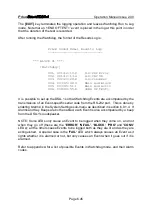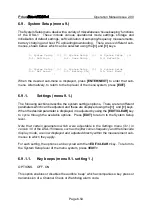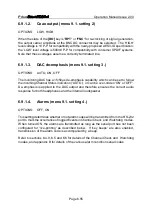
Prism
Operation Manual Issue 2.00
Page 6.41
6.5.2.
Setup (menu 5.2.)
The Channel Check Setup mode is used to configure the Channel Checker and to
verify that everything is set up properly before running the Channel Checker to Log.
The display format is:
Specify channel:
Ù
ChA 24b -OK-
The bottom line of the display has two adjustable fields, the sub-frame (channel)
selection and the audio word-length, as well as an indication at the right of the current
status of the Channel Check receiver.
The flashing arrow highlights the currently-selected field, which is adjusted using the
[<] and [>] keys. The [ENTER/NEXT] key is used to select the desired field.
Channel Check mode can work on either the A or B sub-frame, or both (A&B).
Obviously the single-channel mode should be used if the data path to be tested has
only a single-channel capability. When the single-channel mode is selected, the
[CHAN] key at the bottom of the DSA-1 keypad determines which channel is to be
tested.
The audio word-length to be checked can be set to 16, 20 or 24 bits. This should be
set to match the capacity of the data path to be tested or, if the data path has some
intermediate capacity, to the next smaller value. Setting this value larger than the
capability of the data path to be tested results in continuous failure of the Channel
Check receiver to match the test pattern.
The '-OK-' indication shown in the example above shows that the Channel Check
receiver is successfully receiving the test pattern over the channel(s) and word-length
selected. At this point, the Run to Log mode described in the section above can be
successfully entered.
If some other message is shown in the lower right-hand corner of the display, then the
test setup is incorrect in some way.
'GEN!'
indicates that the generator mode is incorrect for Channel Check
operation - GEN2 must be selected, set to the 'PRS' function, turned ON,
and the [DO] key setting must be 'FNC'. Note that the Generator must
be set as above even if the DSA-1 is only being used to check the test
pattern and not to generate it (e.g. during remote or off-tape testing);
'----'
indicates that no valid AES3 carrier is detected at the selected test input,
i.e. carrier FAIL. Either the sourcing equipment is operating incorrectly
or the wrong test input is selected on the [DI] key;






























